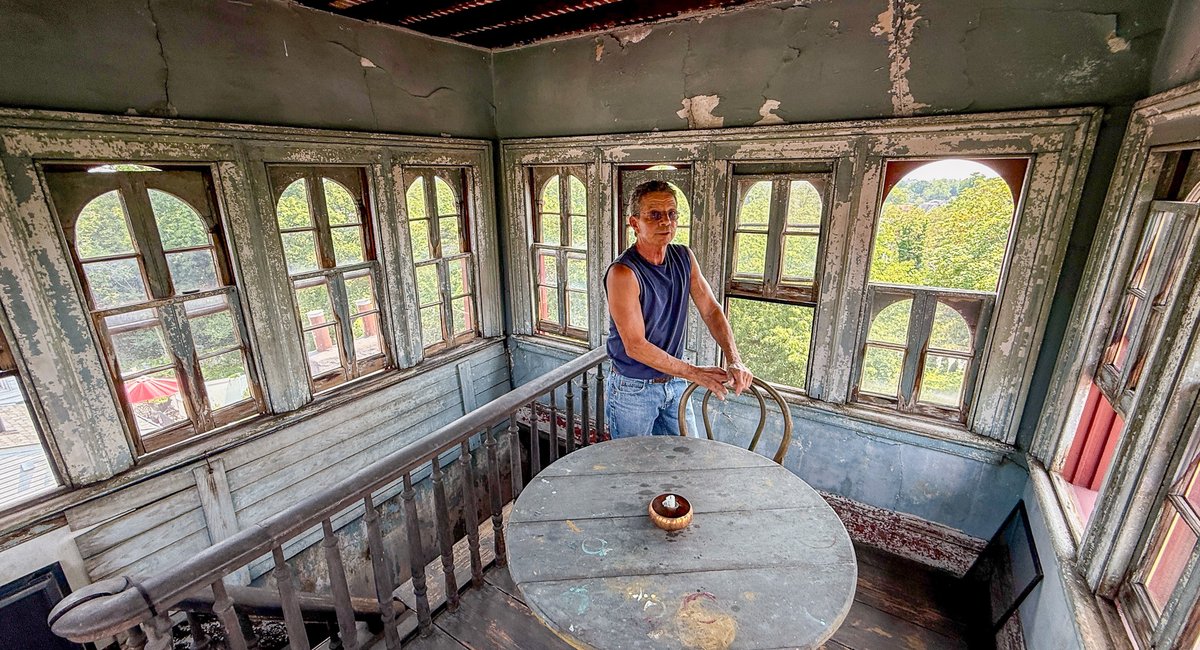Few New Yorkers may know there’s a 19th-century Italianate villa tucked above the busy commercial strip of Richmond Road in New Dorp, Staten Island.
The former home of Gustav Mayer, the German-born baker who invented the Nilla wafer, stands just four blocks from the New Dorp train station. With its original pine floors and 120-year-old working icebox, the home serves as a largely untouched reminder of Staten Island’s rural past.
The Gustav Mayer house is four blocks from the New Dorp train station.
Ryan Kailath / Gothamist
The front of the house sits atop a crest that slopes down a half acre landscaped garden to busy Richmond Road.
Ryan Kailath / Gothamist
From Richmond Road, the house appears part-Gothic novel, part-wedding cake. A wide front porch spans the full building, with carved wooden columns and original wavy glass windows look out on a sloping lawn.
Many of the heirloom plantings date to the 1930s, according to Robert Troiano, the current owner.
The house’s exterior was landmarked in the 1980s. The back entrance faces a quiet residential street.
Ryan Kailath / Gothamist
The front porch stretches as wide as the building.
Ryan Kailath / Gothamist
The home’s original owner David Ryers was a commander in the New York state militia and the last proprietor of the nearby Rose and Crown Tavern, which, according to the Historical Marker Database, was occupied by the British during the American Revolution and is the site where Gen. William Howe read the Declaration of Independence to his officers on July 9, 1776.
In 1855, according to an NYC Landmarks Preservation Commission report, Ryers tore down the tavern and built this house in its place, inspired by the landscape architect Andrew Jackson Downing.
The 2,400-square-foot parlor floor is currently the living quarters, which Troiano updated with a modern renovation.
Ryan Kailath / Gothamist
Mayer, the German-born confectioner, bought the house in 1889 and moved there in 1890. In the basement, he tinkered with recipes and eventually created what became Nabisco’s Nilla wafer.
Upstairs, Mayer’s daughters Paula and Emilia turned the house into a personal canvas. Both women lived here into their hundreds, never married, and painted Swiss and Italian landscapes from their travels directly onto the walls.
Troiano visited Paula Mayer near the end of her life, when a nurse had moved the two daughters to Maryland.
Paula Mayer painted murals throughout the second and third floors and decorative elements on tilework and cabinets throughout the house.
Ryan Kailath / Gothamist
Ryan Kailath / Gothamist
Troiano grew up nearby and bought the home in 1990 after noticing it for years.
“I was a restorationist and woodworker looking for a project,” he said.
Troiano spent decades rehabbing the structure from the inside out, rebuilding the rooflines, restoring the 19th-century windows, and preserving Paula Mayer’s murals, he said.
“Everything is original,” Troiano said. “The yellow southern pine clapboard is original from 1855. The longleaf southern pine flooring is probably $50 a square foot in salvage yards. I put back any pieces that might’ve been tampered with or missing.”
Robert Troiano rented the house out for photo shoots for years, but stopped a few years ago. He’s now planning to sell it.
Ryan Kailath / Gothamist
The third floor has additional bedrooms that serve as photo backdrops.
Ryan Kailath / Gothamist
Ryan Kailath / Gothamist
The utilities are modern, but you won’t see an outlet unless you know where to look.
The house is crowned with a square cupola, which was once used for cooling the home in the summer and taking in ocean views. On clear days, it overlooks Raritan Bay and Sandy Hook, New Jersey.
The cupola atop the house has views of Raritan Bay and Sandy Hook.
Ryan Kailath / Gothamist
Paula Mayer’s paint still stains an original table
Ryan Kailath / Gothamist
Over the years, the home became a destination for the fashion and film industries.
The home’s controlled decay, complete with peeling paint, sun-bleached shutters and patched plaster, attracted photoshoots for magazines including Vogue, Cosmopolitan and Essence.
Gisele Bündchen, Mary-Kate Olsen and Amber Heard have shot here, Troiano said.
“The first shoot was ‘Saturday Night Live’ in 1990, for a skit called ‘Fuzzy Memories,’” he recalled.
Paula Mayer’s decorations appear throughout the house.
Ryan Kailath / Gothamist
Designs for Gustave Mayer’s biscuits.
Ryan Kailath / Gothamist
Robert Troiano is only the second owner of the home since 1889.
Ryan Kailath / Gothamist
Troiano stopped renting the space for photo shoots during the pandemic and is now preparing for a move south.
The home, which has only had two owners since 1889, is now on the market, with an asking price of just under $1.5 million.
“The new owner reserves the right to do whatever they want with the house,” Troiano said. “Although I might prefer it was maintained historically, it’s not a criteria by any means.”
Other Cool Places
The interior of a living room.
Ryan Kailath / Gothamist
